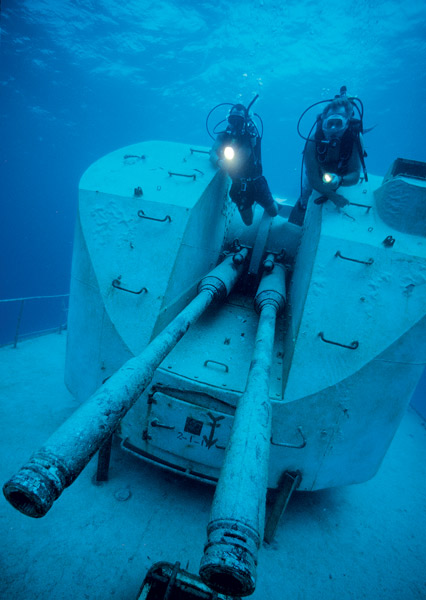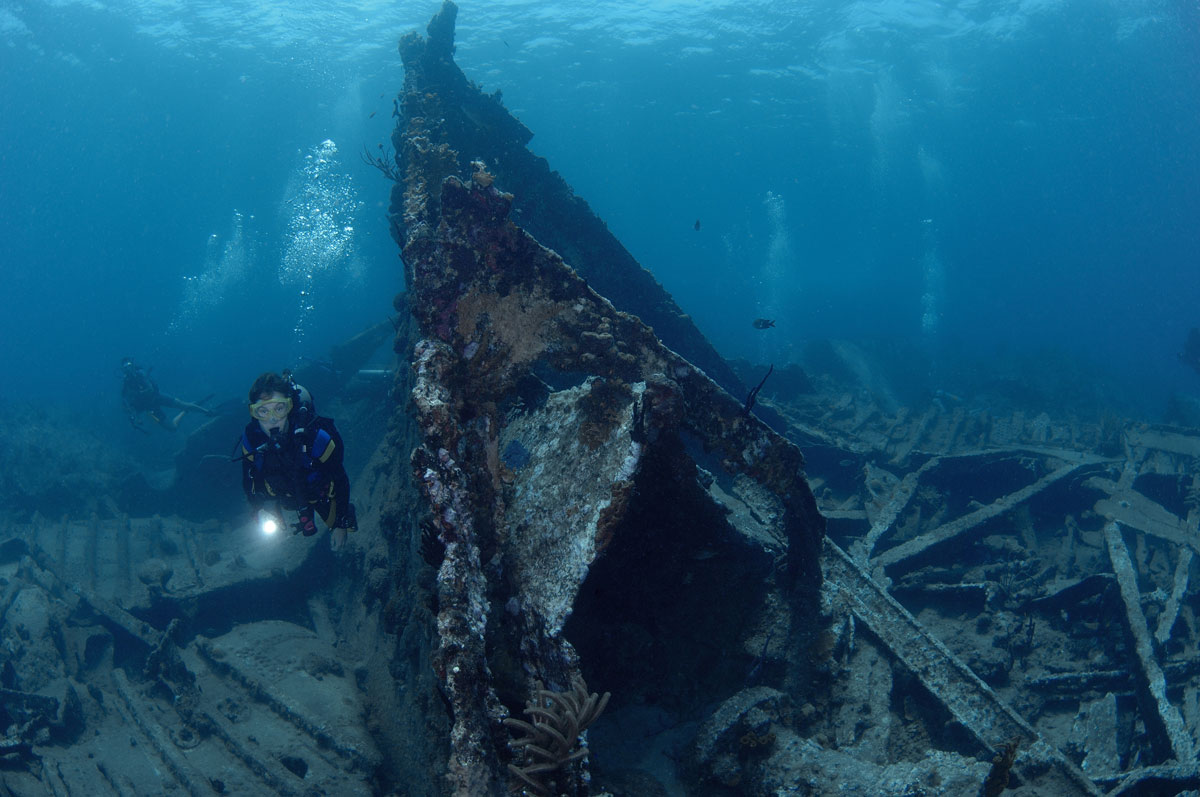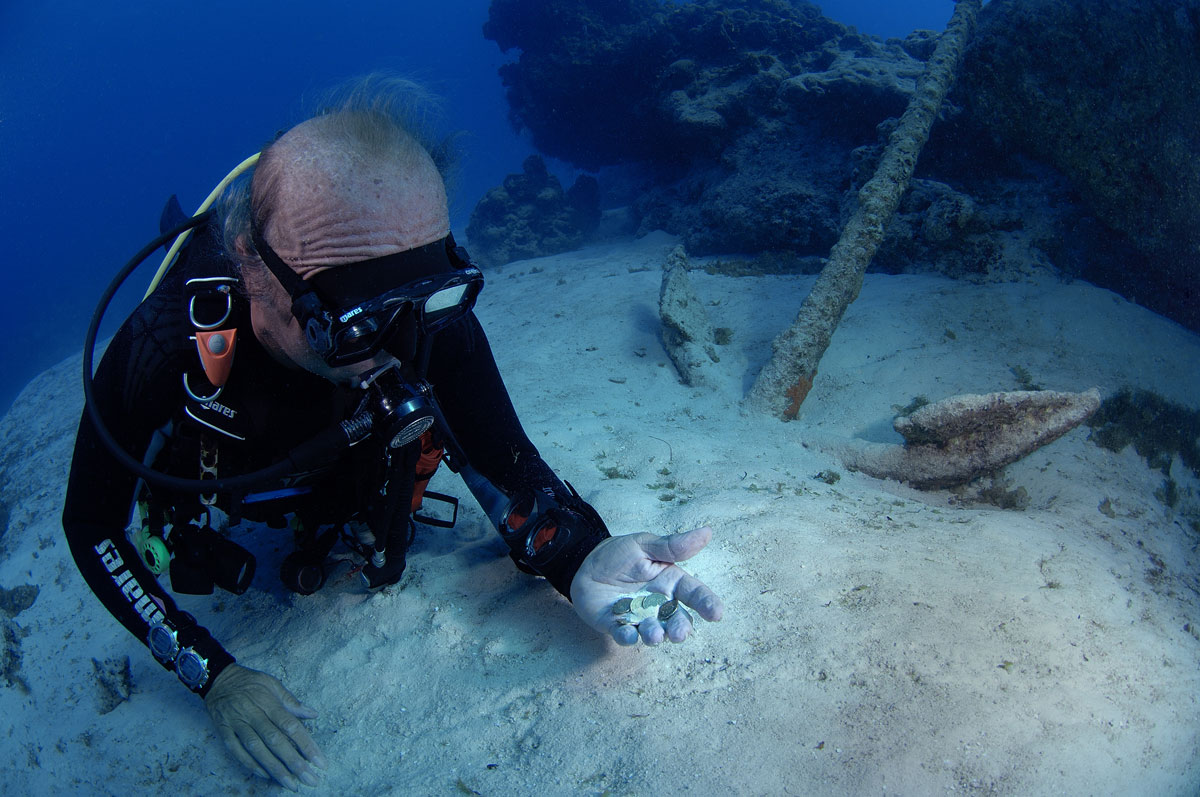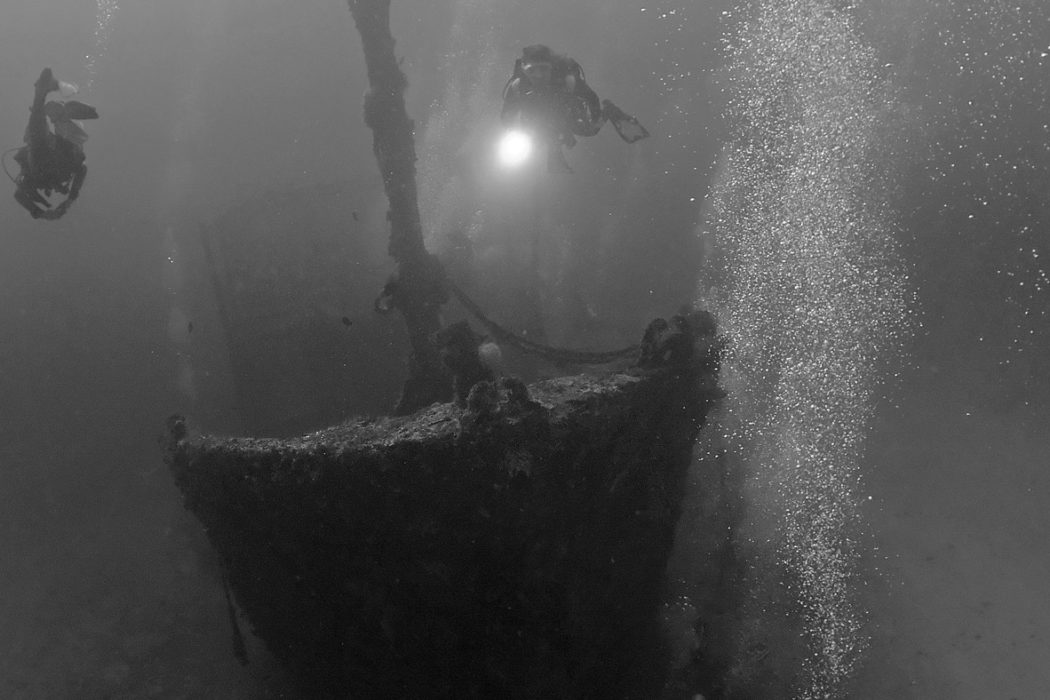The sport of scuba diving is certainly diverse, with something for everyone — at every depth and all experience levels. For some divers it’s captivating coral reefs with rainbows of colors and fascinating tropical fish. For others it’s the excitement of encountering sharks, rays and other large animals. Cave diving is another pursuit driven by the quest for discovery and an attraction to uncharted tunnels and passageways. But just what is it about shipwrecks? The interest in wreck diving seems to have increased, as evidenced by the greater number of wrecks deliberately sunk as “attractions” for divers to enjoy. Whether they’re sunk intentionally as artificial reefs or recently discovered archaeological treasures hidden in their watery graves for centuries, for whatever reason, shipwrecks draw divers.
Wreck Diving and the ‘Why’
Ships end up on the bottom of the ocean, lakes and rivers due to navigational errors, collisions, storms, wartime casualties or as a result of onboard mishaps such as fires or explosions. Also, there are more and more ships now being sunk intentionally to create artificial reefs. In general, shipwrecks in shallow waters and close to shore are the easiest to access and dived the most. Deeper wrecks and ones in more remote areas are dived the least. Many remain undiscovered or undived. With technological advances in sonar and magnetometer technologies, new wrecks are found every year in all oceans of the world. And more and more ships are also being sunk purposely to form reef environments to benefit divers and fishermen.
The fact that shipwrecks offer a habitat for marine life is especially important in areas that have few natural reefs. The many flat, featureless areas of the Gulf of Mexico’s continental shelf make it prime for artificial reefing. The USS Oriskany sunk off Pensacola, Florida, in May 2005 and the Texas Clipper put to rest in Texas waters off South Padre Island are two examples of ships-to-reefs.
RELATED READ: THE BEST WRECKS IN AMERICA’S NATIONAL MARINE SANCTUARIES
Serious wreck divers seem to have an innate sense of exploration. It’s part of their core being. They live to venture where few if any have been. They yearn to unravel information and to discover what has not been known. To penetrate and explore the interior of a wreck, especially if few or none have done so, is a thrill that fuels the passion for discovery.
For some that pursue wreck diving, historical interest is the driving force. Shipwrecks are like windows into the past. Researching the background and circumstances that led to the tragedy and then visiting the wreck site years, decades or perhaps centuries later can be like taking a journey through a time warp. Other divers are simply fascinated by the size of many wrecks and the major components and machinery that can be approached and viewed in a way that would never be possible before it sank. To swim past a colonial-era fluked anchor or to see an old crusty cannon laying in the sand can conjure thoughts of another era. Or to swim through an engine room, a bridge or crew quarters may make one wonder about the life on board the vessel years ago when it was underway plying the seas. Shipwrecks also offer many divers an environment to simply advance and hone their diving skills. A very large wreck upright in warm, clear water provides a perfect environment for several levels of development from Advanced Open Water, to various specialties and technical diver ratings.
Serious wreck divers seem to have an innate sense of exploration. It’s part of their core being.
Here are responses from several seasoned wreck divers when asked the “Why” question: “It’s the challenge and exploration of the unknown,” says Gary Gentile, famed wreck diver and author. “I always feel excited heading down the anchor line as I think about what I might discover inside the wreck, even if it’s a wreck I’ve dived before.” For Great Lakes wreck expert David Trotter, “It’s the desire to discover, explore and solve the mystery of ‘ships gone missing.’” Author of “Shipwrecks in the Sunshine State,” Michael Barnette says, “The factors that compel me to explore shipwrecks are curiosity, a fascination with maritime history, and a natural love of the ocean.” Barnette prefers “particularly deep or unidentified shipwrecks — places no one has been before.” United Kingdom wreck diver and explorer Leigh Bishop uses mixed gasses to “venture to areas where no dive charter has been before.” Leigh considers now “the Golden Age of shipwreck discovery around England” where he says there are more wrecks per square mile than anywhere in the world.

Divers swim past the guns on the MV Keith Tibbets off Cayman Brac. Photo by Jesse Cancelmo.
Wreck Diving Training and Safety
Wreck diving poses a unique array of hazards for any diver. Because so many wrecks constitute snags and obstructions on the seabed, trawler nets and high-test monofilament fishing lines are commonly strewn across wheelhouses and hulls. Now factor in low or no ambient light and an overhead environment that can easily trap a diver and prevent free ascent to the surface. Inside there may be sharp edges, loose cables, structurally unsound bulkheads, and a maze of passageways. Many wrecks fill with silt or mud that can easily stir, resulting in reduced visibility and serious orientation challenges. A diver trained only to an Open Water level has no more business penetrating a shipwreck than entering a cave.
Wreck diving is an advanced skill and requires special training and equipment. But the necessary skill sets for wreck diving vary widely depending upon the specific circumstances: depth, water temperature, condition of the wreck, sea or lake conditions, and the degree of penetration, if any. Whereas an Open Water certification is adequate training to dive outside and around a shallow, tropical-warm water, well-lit, “trap-free” wreck in, say, Bermuda, to safely dive a deep, coldwater wreck like the Andrea Doria is the other extreme that requires special equipment and a training and experience level way beyond Open Water. Many wrecks at recreational depths are intermediate-level dives most of the time but as conditions change, namely current or visibility, they can transform into very advanced dives.
The best advice is to do plenty of homework on wreck diving and get additional training before attempting wreck penetration.
- Talk to the dive operator about the wreck or wrecks to make sure you have the proper skill level, experience and equipment for the dive.
- Make certain you are properly outfitted for wreck diving and your gear is streamlined and snag free. Check for proper hose lengths and dive with only essential gear. Essentials while wreck diving may include two knives or cutting tools, primary and spare lights, reel and line, lift bags, alternate and redundant air supplies or more depending upon the dive.
- Divers making repeat dives to a wreck need to be cognizant that the sea is constantly taking its toll. A section or a wreck that was sound and stable a few months ago may have become unstable over time.
- Also, even after completing advanced and wreck diving courses, always take one step at a time in your progression as a wreck diver. Never make a dive changing more than one new variable. For example, if you are accustomed to warm-water diving, start with a wreck in warm water and begin by exploring only the outside of the wreck. Attempting a first-ever dry suit dive coupled with first-ever penetration is taskloading, and the load might just be too much too handle in one outing.
Penetrating a wreck is a serious decision and should never be done on a whim without solid preparation, proper equipment and a well-thought-out plan. Wreck diving holds a wealth of opportunity for exploration and discovery. From the Great Lakes to Great Britain, and from North Carolina to the South Pacific, there’s a near endless list of wrecks waiting to be explored. Start training now and you’ll have a lifetime of adventure waiting for you as a wreck diver.

A diver explores the RMS Rhone in the British Virgin Islands. Photo by Jesse Cancelmo.
Maritime History
In all likelihood, the first boats built go as far back as the Stone Age when dugout canoes were used for fishing. Ancient civilizations relied upon rivers and seas for fishing, transportation and trade routes. As early civilizations developed, man realized that the most practical method for moving large quantities of materials or large numbers of people long distances was by floating them in a vessel. Ships clearly affected the course of our civilization. Historical records have tremendous value but artifacts provide a different insight to where we came from and how our ancestors lived their lives. Shipwrecks really are portals to the past. Many clues to where we came from remain hidden in ancient wrecks in the sea.
The use of navigational methods dates back at least 5,000 years. In 3000 B.C. the ancient Egyptians developed the first vessels powered by wind. Egyptians used their wooden-hulled ships to explore the far reaches of the Red Sea. But the Aegean Sea gets the credit for being the cradle of maritime history in the Western Hemisphere.
“Before there were shepherds or farmers in Greece, there were sailors,” says George F. Bass, pioneer and father of underwater archaeology. In the early Bronze Age (3000 B.C.) sailors moved copper and bronze materials between Crete, Asia Minor and the Greece mainland. But by 2000 B.C. the Phoenician civilization had developed a maritime trading economy that spread across the entire Mediterranean Sea. They moved along the northern African coast returning with riches from Spain and Great Britain in ships with sickle-shaped hulls and straight-rising stem and stern posts. By the end of the first century and after a series of wars, the Romans became a major maritime power that controlled the Mediterranean, or “Inner Sea.” They were the most powerful empire in the Western Hemisphere and their elite demanded silk, spices and other exotic goods from the far reaches of that time, namely Egypt and Arabia.
During the Middle Ages, Norsemen from Scandinavia used their vessel-building prowess to raid Britain and Ireland from the sea. Their double-ended designs with dragon-headed prows were constructed of overlapping oak planking and were powered by both oars and wind. When the wind was inadequate to fill the massive square sail, up to 20 oarsmen took over to power these sleek, efficient troop carriers.
By the 15th century, Europeans were venturing out to sea establishing new commerce routes and trading partners. Soon after the historic Columbus voyage in 1492, European sailors recognized the wind patterns in the North Atlantic caused a clockwise sailing route to and from the New World. At that time the Europeans were in heavy economic competition for natural resources and were establishing colonies to secure their country’s power and wealth. The British, French, Portuguese and Dutch were all flexing maritime might to stake their claims. In 1578, Sir Francis Drake became the first to circumnavigate the globe in a galleon-design merchant ship. Later the sleeker, faster clipper ships were used to further expand trade between the West and the East.
Maritime commerce in America’s Great Lakes has its roots in the days of the French fur trade. But it wasn’t until after the War of 1812 that permanent settlements flourished and commercial shipping expanded. Ship traffic picked up during the Civil War era and increased steadily through the early 20th century. Schooners, paddlewheelers, freighters, and passenger cruise liners crisscrossed the often treacherous waters of the Great Lakes. Over the years, thousands never made it to their final destinations.
America’s first Continental Navy was established in 1775 with only six frigates. Naval ships and their designs were crucial in the early years of the United States, from the Revolutionary War and through the War of 1812 and the Civil War. Ship design progressed from sail and oar power to steam engines. Although prototype submarines date back to the late 1500s, it was during the 19th century that submarine designs were advanced for effective use in warfare. The famed battle of the ironclad CSS Virginia and the USS Monitor at Hampton Roads in 1862 had a major effect on the future of naval ship design and warfare.
In the 1900s, modern internal combustion engines replaced steam engines and steel-hulled ships gradually replaced the wood-hulled fleets. Ocean liners replaced sailing vessels while the navies retooled their fleets with destroyers and armored cruisers. The Germans used submarine warfare in 1917 to strangle the Allied shipping commerce and World War I saw the first use of aircraft carriers.
By the time the United States entered WWII, German U-boats were stalking and sinking Allied ships along the East Coast of the United States and Canada as well as in the Gulf of Mexico and the Caribbean. German submarine technology and production advanced rapidly. More than 1,100 U-boats were launched during World War II, but by 1943, the Allies were producing ships at a rate faster than the U-boats could sink them. Eventually new detection technologies and improved naval tactics resulted in fewer U-boat casualties. In the Pacific Ocean between 1942 and 1945, hundreds upon hundreds of ships were sunk in hard-fought battles across the Pacific southwest region.
In July 1956, the Italian passenger liner Andrea Doria collided with the MV Stockholm near Nantucket, Massachusetts. It went down in 250 feet (76 m) of water that rarely is above 48 degrees Fahrenheit (9 degrees Celsius). In 1991 the maritime tragedy was the Salem Express and in 2006 it was the Al-Salam 98. Both were Egyptian ferries heavily loaded with workers and pilgrims that capsized in the Red Sea. Every year trawlers, tankers, ferries, cruise ships and even submarines end up wrecked underwater.
Marine Archaeology
Part historian and part scientist, archaeologists thrive on painstaking efforts to locate, retrieve, identify and catalog artifacts. They are trained to discover and preserve the lost and forgotten, whether buried in the ground or hidden on the bottom of the sea.
Most marine archaeological sites are shipwrecks but some are the result of earthquakes. There are also ancient villages once located near the sea that are now underwater due to rising sea levels since the last Ice Age. For shipwreck sites, the ship, the cargo and the crews’ personal effects are all important for better understanding the social, economic and political conditions of the past.
The chemical composition of the water environment, depth, temperature and level of light are all factors that can affect the condition of a wreck over time. Deeper wrecks tend to be better protected whereas shallow wrecks can be subject to commercial activities such as shipping, fishing, and oil and gas development. Shallow wrecks can also be affected by wave action from hurricanes and storms or from surf action. Salt water will rapidly corrode iron-based wrecks and artifacts. Sea organisms like the teredo navalis worm destroy wood and other organic materials. Fresh water is significantly less hostile than seawater. The cold, freshwater wrecks in the Great Lakes are incredibly well preserved, and many are almost fully intact after hundreds of years of submersion. The unusually low deterioration rate in this environment sustains an underwater museum for schooners, side-wheel steamers, passenger freighters and brigantines. Wooden barkentines from the 1800s remain upright with standing masts and secured yard arms.
In the sea, a cover of sediment can preserve an old wreck by protecting it from organisms and oxidation. The dilemma many underwater archaeologists face is weighing the cost of a proper archaeological investigation with the potential value of the recorded recovery, and knowing that as the clock ticks, the underwater records are further deteriorating. Wrecks and artifacts removed from the ocean need to undergo a very special and lengthy preservation process. It can take years to fully stabilize materials that have been in the ocean. In 1960, George Bass, professor emeritus from Texas A&M University, was the first person to lead an excavation of an ancient shipwreck in its entirety underwater. But not all historically significant shipwrecks are excavated underwater. The French explorer Sieur de La Salle lost one of his ships in a shallow Texas Bay in 1685. More than three centuries passed before it was discovered buried in mud at a depth of 12 feet (4 m). The archaeologists devised a plan to excavate the wreck in place “dry.”
From the antiquities to the modern era, shipwrecks are time capsules waiting to be opened. Some lay upright, while others upside down or resting on their sides. Over time many become buried in the silt and protected. Ones left exposed to the harsh elements of the sea eventually break into pieces, crumble and become a scatter of parts and pieces.

Photo by Jesse Cancelmo.
ARCHAEOLOGISTS VS TREASURE HUNTERS
Marine archaeologists and treasure hunters have been at odds for years. Archaeologists complain that treasure hunters disturb and often destroy wreck sites. They say treasure hunters often diminish their ability to systematically obtain knowledge from the remains of the ship. Marine archaeologists are especially critical of treasure hunters seeking financial gain over historical recovery and knowledge. Archaeologists often accuse treasure hunters and collectors of depriving them of finds and destroying critical information contained in the wreck. At best the treasure hunters are deemed ignorant of proper recovery and cataloguing techniques and, at worst, they are called looters.
Many treasure hunters make the simple argument of “finders keepers” and rely on Admiralty Laws to support their salvage claims and treasure finds. With the spirit of adventure and itch for mystery fueling countless hours of research followed by costly searches of the depths, the finders argue they paid their dues and deserve the spoils for the risks taken. They claim that archaeologists overplay the “historically significant” card. They insist that many shipwrecks are no more than wrecked trucks or buses that had hulls instead of wheels. And it doesn’t have to be a gold or silver find. It may be an artifact as simple as an old bottle or a brass spike. Purist wreck divers argue for leaving everything as it is for others to see and for the next generation to enjoy, yet collectors often argue that if they don’t take it now, the sea eventually will. Teddy Tucker, Bermuda’s pioneer wreck salvor, once said that marine archaeologists “want to control everything.” He contends that many archaeologists recover important artifacts only to load them in warehouses instead of making them accessible to the public. Another complaint is that the marine archaeologists don’t do enough to educate the layman on the significance of wreck artifacts. The “treasure hunter versus archaeologist” arguments continue but it is inarguable that the search for artifacts of the past inspires many.
USS HATTERAS
A significant event in U.S. history occurred off the coast of Texas on January 11, 1863. The USS Hatteras, a 210-foot-long iron-hulled side-wheel steamer sent south to blockade the port of Galveston, sighted a suspicious set of sails in the distance. After a four-hour chase, the Yankee gunboat armed with four 32-pound cannons caught up to an unidentified black-hulled square-rigger. Initially the vessel in pursuit identified itself as the Spitfire under British flag but as soon as the USS Hatteras commander Homer C. Blake let his guard down, the black-hulled ship announced its true identity as the CSS (Confederate State Steamer) Alabama and blindsided the Hatteras with a point-blank broadside gun blast. In 13 minutes the USS Hatteras was on the bottom in 40 feet (12 m) of water. The Alabama suffered no damage. Two Union crewmen were killed. Today most of the ship is buried beneath the sand and mud 28 miles (45 km) due south of Galveston. Parts of its 500-horsepower walking beam steam engine and the tops of both of her paddle wheels protrude from the bottom. The Hatteras is a direct link to the Civil War and it has great historical significance as a naval wreck that sank under battle off the coast of the United States.





